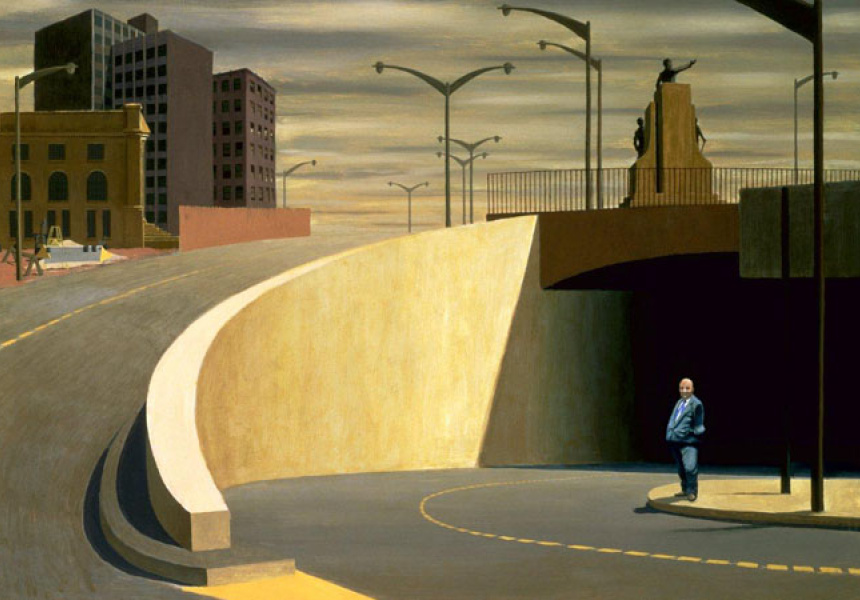For seven decades, Jeffrey Smart's paintings have captured our collective imagination, depicting poignant, still, hyper-real urban moments.
TarraWarra Museum of Art is now hosting Jeffrey Smart: Master of Stillness, a major retrospective featuring works from 1940 to 2011, when he announced his retirement at the age of 90. The exhibition is hung in TarraWarra's monumental gallery, set in the rolling Healesville countryside – a striking contrast to Smart's concrete-scapes – and was assembled by Barry Pearce, emeritus curator and long-term friend of the artist.
The selection of paintings follows Smart's development as an artist from his early years growing up in Adelaide, to Sydney, Rome and then finally Tuscany, where he has now lived for decades. Assembling the body of work in one gallery also reveals Smart's key preoccupations as they appear again and again across the years: portraits and the individual, the modern urban landscape and its clean lines, moments of time and stillness, bright colour and light, and the journey of the artist. As curator Barry Pearce explains, “Smart created an entirely new vernacular of modern painting. He confronted a brave new universe of technology and architecture and declared that it was beautiful. He became its poet.”
Never miss a Melbourne moment. Make sure you're subscribed to our newsletter today.
SUBSCRIBE NOWAll of Smart's key works are represented in the exhibition: the iconic Cahill Expressway (1962), in which a tubby, bald, one-arm man stands staring out from the curve of an empty expressway; Portrait of David Malouf (1980), a study of the overall-clad Australian writer working in an industrial lot, a red hose cheekily curling in the foreground; and the Container Train in Landscape (1983-84), on loan from prime position in Melbourne's Arts Centre.
Container Train stands out as unusual because, unlike many of his other works, Smart is not depicting people. Instead, a string of colourful shipping containers is the subject, as they stretch across a bush landscape, foregrounded by gum trees. At 10 metres long, the sheer size of the work means that as a viewer you inevitably walk its length when you encounter it. Moving alongside the train, something that would usually move alongside you instead, conjures up a slow-motion rhythm, a moment in time – which is the essence of all Smart's work.
So many pieces seem to take a moment in time and make it stand still. Even in those that should have a sense of movement such as Morning Practice, Baia (1969), where a man balances a cube with his feet, or Off Brindisi (1985) in which a figure sits on a rocking boat, it is as though the world is frozen.
Smart is interested in exploring the passing of time and is fascinated by J.W. Dunne's theory that the past, present and future could all be one and the same thing (a concept that also preoccupied writers like T.S. Eliot). Curator Pearce explains that Smart is taking the viewer on a dance with colour, measurement and proportions revolving around and settling on the elusive eternal moment; he is interested in how to deal with the passing of time in his artworks, and his answer is 'stillness'.
Over the years, Smart's work has been described as many things – surreal, hyper-real, architectural, a “study in modern alienation”, due to his oft-isolated figures on roads, bridges and vacant lots. In fact, it would be far more accurate to describe many of the works as portraiture, as he has so often painted individuals, be they famous figures such as David Malouf and Clive James, everyday people, or himself. But by placing these figures alone in stark concrete landscapes, Smart is not necessarily describing alienation. Instead, many of these portraits can be seen as a reflection on creative life, on its solitary work, artistic struggles and joys – Smart is revealing his individual vision and experience to us.
In his final work, Labyrinth (2011), a figure walks alone through a complex maze. Pearce describes it is a visual metaphor for an artist's creative life, in which they will certainly get lost, contemplate which direction to go in and find new paths. It’s an especially poignant reflection – the final painting, bookending both a career and the show.
Jeffrey Smart: Master of Stillness runs until March 31 at TarraWarra Museum of Art. The exhibition has a companion section (work from 1940-51), showing at Carrick Hill, Adelaide until February 24.



